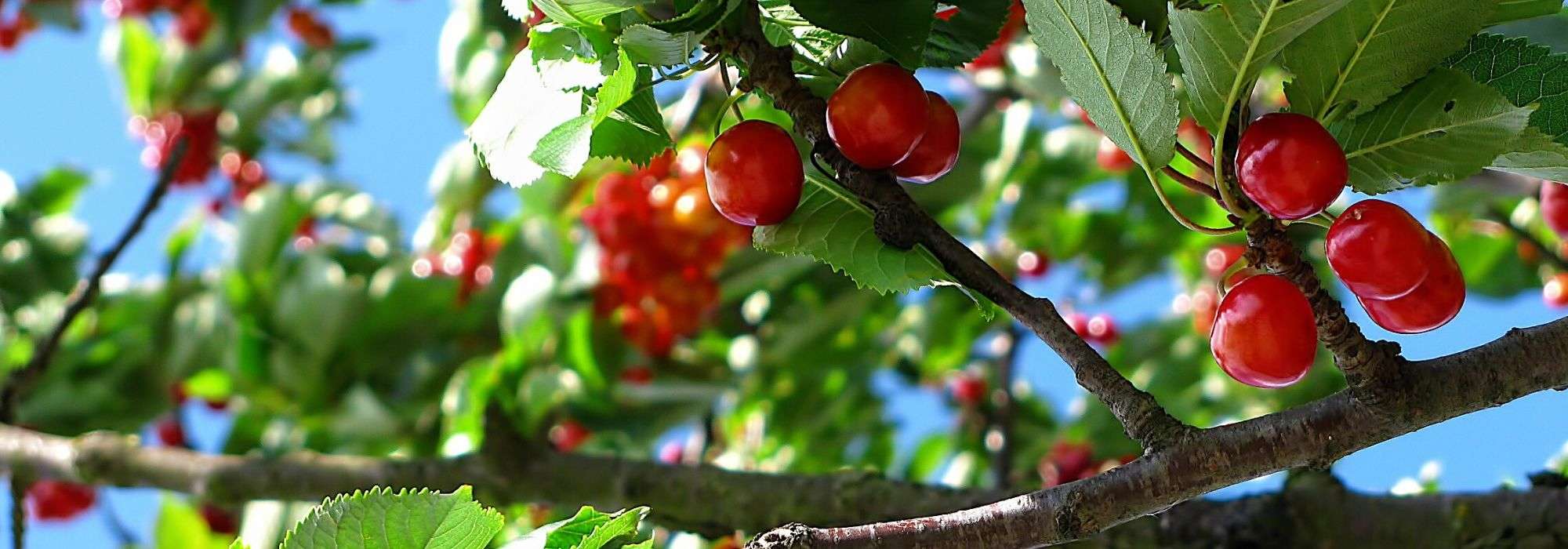
Cherry tree: planting, pruning, care
Contents
Cherry tree in a nutshell
- The Cherry tree is a fruit tree that produces, depending on the varieties, sweet cherries (Prunus avium) and sour cherries (Prunus cerasus)
- The varieties Burlat, Napoleon, or Cœur de Pigeon are the most commonly consumed
- The harvest of cherries takes place from May to August
- Hardy, it can withstand temperatures down to -20 °C
- Easy to grow, it thrives in all types of soil, whether acidic or chalky, cool and light
A word from our expert
The cherry tree is one of the most common fruit trees in gardens. There are sweet cherries (Prunus Cerasus) with varieties like ‘Burlat’, ‘Napoleon‘ or ‘Coeur de Pigeon’, which are the most well-known and delicious cherries, and sour cherries (Prunus avium), which are more acidic and ideal for jams, preserves, and brandy. While some cherry trees are self-fertile, others absolutely require another cherry tree nearby to ensure good fruiting.
Having a cherry tree in your garden also means enjoying a stunning ornamental tree. The spectacular white flowering of this cousin of the Japanese cherry tree heralds the arrival of spring, and the leaves of some cherry trees offer beautiful autumn colours.
Hardy and disease-resistant, the cherry tree can withstand temperatures down to -20°C and adapts to all regions of France.
It can be planted alone on a lawn, at the back of a flower bed, within an orchard, or even in a pot on a balcony or terrace for dwarf cherry trees.
Once well established, it requires almost no care to enjoy beautiful cherry harvests!
At what age does a cherry tree bear fruit? When and how should you plant a cherry tree? Discover our tips for growing this generous fruit tree!
Description and botany
Botanical data
- Latin name Prunus cerasus, Prunus avium
- Family Rosaceae
- Common name Cherry tree
- Flowering March to May
- Height 1.50 to 10 m
- Exposure Sun
- Soil type rich and light
- Hardiness -15-20°C
The cherry tree (Prunus cerasus, Prunus avium) is a fruit tree from the Rosaceae family, native to Asia Minor, that has acclimatised to all regions of France.
The vast genus Prunus includes a large number of species and varieties, including ornamental flowering cherries and fruiting cherries, which are divided into two species:
- The Prunus cerasus, which produces sour cherries; the griottes, also known as morelles, with a tangy flavour and soft flesh
- The Prunus avium (sweet cherry or bird cherry), which produces sweet table cherries: the bigarreaux with a sweet taste and firm flesh and the guignes (‘Early Rivers’), which are sweet cherries like the bigarreaux but with a softer flesh
The true cherry is a cross between “sweet cherries” and griottes, possessing flesh with a flavour that is both sweet and tangy (Cherry ‘Belle Magnifique’).
Each of these cherry species has undergone significant selection and countless cross-breeding, resulting in many varieties, including the Bigarreau Cherry ‘Burlat’, which is the most cultivated table cherry, and ‘Cœur de pigeon’, among the most widespread and consumed, as well as ‘Montmorency’ for griottes.
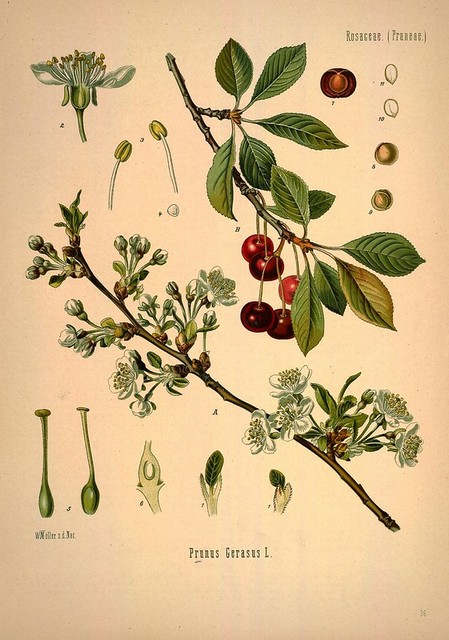
Prunus cerasus – botanical illustration
The cherry tree forms a majestic medium-sized tree, reaching 5 to 10 m in height when mature, with an upright or spreading habit and a rounded crown. Its growth is quite rapid, growing up to 1 m per year. Some have a compact habit and are well-suited for small gardens, such as the Dwarf Cherry ‘Garden Bing®’, which does not exceed 1.50 m in height at maturity. The cherry tree has beautiful decorative bark, reddish-brown, smooth and marked with horizontal stripes, which remains decorative in winter.
The cherry tree blooms from early spring, from late March to April-May, depending on the climate. The flowering usually appears before the leaves. The cherry tree is covered with countless small pure white flowers in open cups, grouped in pairs or charming bouquets. These very simple and elegant flowers consist of 5 rounded petals and typically measure between 2 and 5 centimetres in diameter. They are borne on a long peduncle and each displays a large bouquet of stamens that attract pollinating insects.
While some varieties are self-fertile (Bigarreau Cherry ‘Summit’, “Montmorency Griotte”), most require cross-pollination, and it is advisable to plant the cherry tree alongside a different variety within a radius of 20 to 30 m to enhance fertility. Most griottiers are self-fertile. While the cherry tree begins to produce cherries from 3 years, and within one or two years for dwarf varieties like the Cherry ‘Cherry Boop®’, fruit production only becomes optimal after 6 to 8 years.
The leaves of the cherry tree are arranged alternately on the branches. They are acuminate, ovate to elliptical, dentate at the edges, and measure between 4 and 12 centimetres in length. Glabrous, they are a bright green, strongly veined, and turn a lovely yellow or reddish hue in autumn before falling. Two small red glands can be observed at the base of the lamina. The foliage of the cherry tree is deciduous: the tree loses its leaves in autumn to produce new ones in spring.
After fertilisation, the petals fall, and on small wrinkled protrusions, cherries appear. The cherry tree produces juicy and tasty fruits, 1 to 3 cm in diameter, from May to August, varying in sweetness depending on the species. The fruit is a fleshy drupe, globular, covered with a thin, shiny skin borne on a peduncle. The variety ‘Cœur de Pigeon’ bears very large heart-shaped fruits. It contains a whitish-yellow or slightly pink flesh, firm and crunchy with a tangy flavour for the Griotte Cherry or sweet for the Bigarreaux. Each fruit contains a smooth, globular to oblong stone that encloses a non-edible almond at its centre.
 The cherry tree is a true spectacle in bloom and a pure delight when cherry season arrives
The cherry tree is a true spectacle in bloom and a pure delight when cherry season arrives
The skin colour of cherries varies from one variety to another, ranging from dark red for the Bigarreau Cherry ‘Burlat’ to bright red washed with yellow in the Bigarreau Cherry ‘Napoléon’, to red, almost black when ripe in the Bigarreau ‘Délice de Malicorne® Agoudel’, and the golden yellow of the Bigarreau ‘Stark Gold’.
Hardy, the cherry tree withstands temperatures down to -20°C, and you can harvest cherries in all regions of France. It can be planted in the garden on a lawn, at the back of a shrub bed, or naturally associated with other fruit trees in an orchard or even in a pot on a balcony or terrace with dwarf cherry varieties.
Cherry wood has a fine, white-pink to brown grain that is highly valued for furniture making and cabinetry.
With the fruits of Prunus avium, kirsch and cherry liqueur are made. In the 18th century, under the influence of Louis XV, new cherry varieties were developed.
“`
Read also
How to protect fruit trees from birds?Main species and varieties
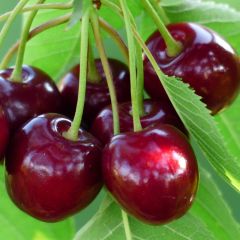
Prunus avium Bigarreau Burlat - Cherry Tree
- Flowering time April, May
- Height at maturity 6 m
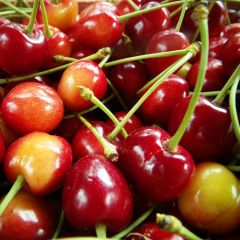
Prunus cerasus Bigarreau Coeur de Pigeon - Tart Cherry Tree
- Flowering time May
- Height at maturity 6 m
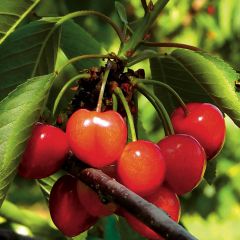
Prunus cerasus Bigarreau Napoléon - Tart Cherry Tree
- Flowering time April, May
- Height at maturity 6 m
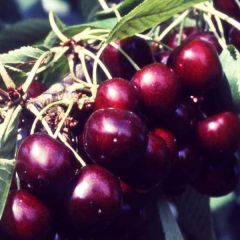
Prunus avium Van - Cherry Tree
- Flowering time April, May
- Height at maturity 6 m
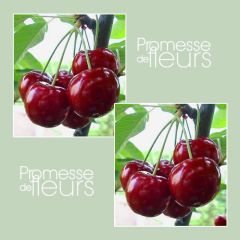
Prunus avium Bigarreau Reverchon - Cherry Tree
- Flowering time May
- Height at maturity 6 m
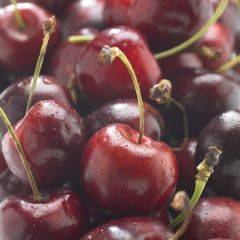
Prunus avium Bigarreau hâtif Delbard - Cherry Tree
- Flowering time April, May
- Height at maturity 6 m
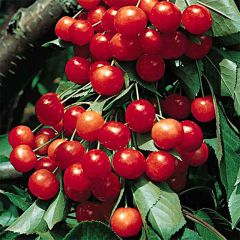
Prunus cerasus Griottier Griotte de Montmorency -Tart Cherry Tree
- Flowering time May
- Height at maturity 5 m
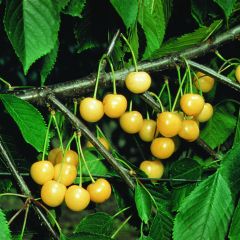
Prunus cerasus Bigarreau Stark Gold - Tart Cherry Tree
- Flowering time April, May
- Height at maturity 6 m
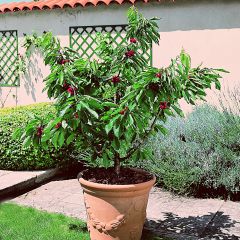
Prunus avium Garden Bing - Cherry Tree
- Flowering time April, May
- Height at maturity 1,50 m
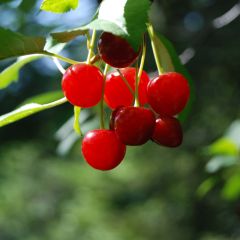
Dwarf Cherry Tree Cherry Boop
- Flowering time April, May
- Height at maturity 2 m
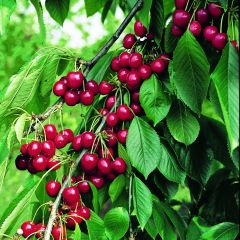
Prunus cerasus Belle Magnifique - Tart Cherry Tree
- Flowering time April, May
- Height at maturity 8 m
Discover other Cherry trees
View all →Available in 1 sizes
Available in 1 sizes
Available in 0 sizes
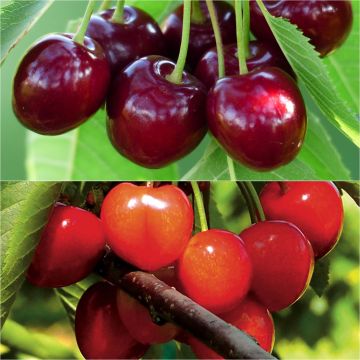
Available in 0 sizes
Available in 2 sizes
Available in 0 sizes
Available in 1 sizes
Available in 0 sizes
Available in 6 sizes
Available in 1 sizes
Cherry tree planting
Where to plant?
Easy to grow, hardy down to -15°C, up to -20°C, the Cherry tree adapts well to all our regions. Choose a sheltered spot from wind and cold in areas with harsh winters, as spring frosts can damage the flowering of the earliest varieties: flowers can be harmed at -2°C. Provide it with a well-sunny exposure, which is essential for producing beautiful cherries.
Not very demanding, the fruiting cherry tree grows in all types of soil, deep, cool, well-drained, only fearing very clayey, shallow, and suffocating soils. It does not like stagnant moisture, which encourages the onset of diseases. Sour cherry species tolerate calcareous soils well.
If you live in a region where it rains often, choose to plant your cherry tree on a mound or slope to allow water to drain away, preventing the development of diseases.
Ensure there is enough space for the tree to develop at maturity and choose a variety suitable for the size of your garden. Self-fertile varieties, which do not require another variety for pollination, are preferable in small gardens!
The cherry tree is generally planted alone on a lawn, at the back of a flowerbed, or within an orchard. Dwarf varieties can be grown in pots, for example, on a terrace.
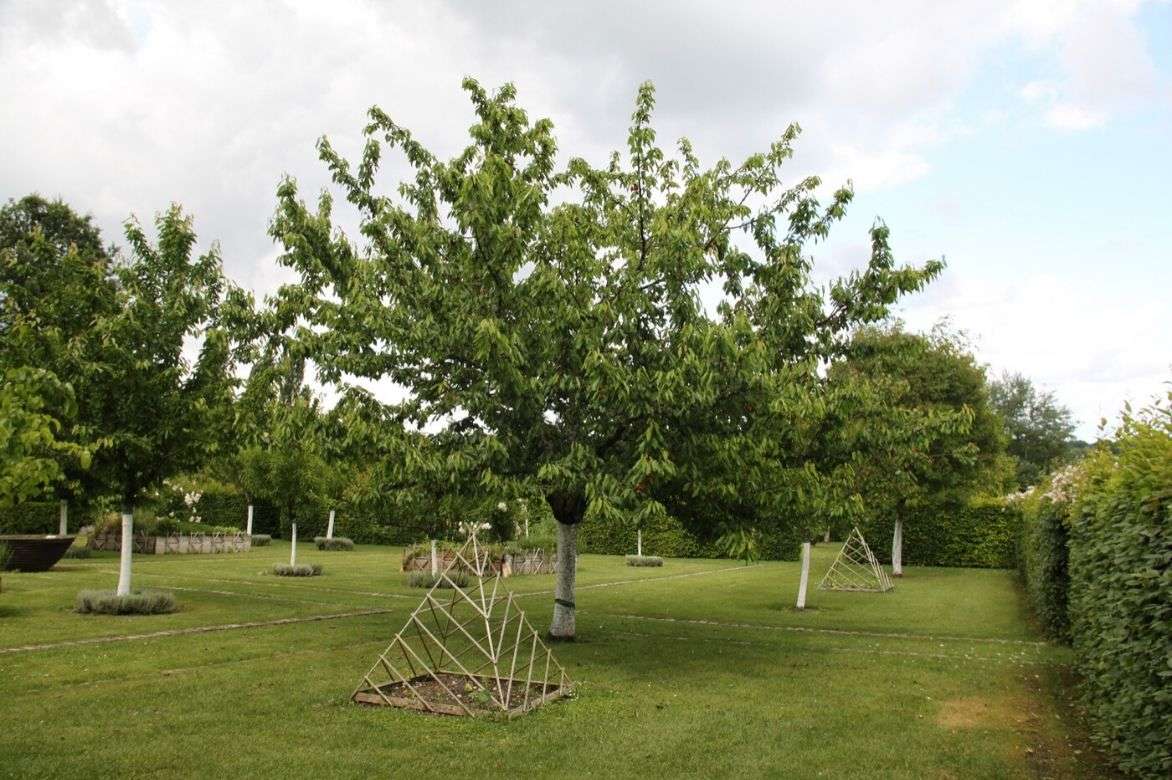
Cherry trees in the garden of Chaigne (Charente)
When to plant?
Planting the Cherry tree should be done preferably in autumn from September to November before the frosts, allowing it time to settle in before winter.
How to plant?
In the ground
If you are planting several trees, space them 8 to 12 m apart for standard cherry trees, 4 to 5 m for medium-sized cherry trees. It is often necessary to have another cherry tree nearby, within a radius of 20 to 30 m, to ensure cross-pollination and good fruiting. In heavy, clayey soil, it is advisable to improve drainage by adding gravel or pumice at planting.
- Soak the root ball in a bucket of water
- Dig a hole 4 to 5 times the volume of the root ball
- Loosen the soil deeply
- Place a drainage layer at the bottom with gravel or pumice
- Gently untangle the roots
- Position the root ball well in the centre of the hole
- Ensure the grafting point is not buried by positioning the collar of the cherry tree at soil level
- Install a stake by attaching it to the plant and crossing the tie in an 8 shape, without touching the trunk
- Fill the planting hole with a mix of garden soil, crushed horn, or well-matured compost
- Firmly pack down
- Water thoroughly (about 10L)
In a pot
Dwarf varieties of cherry trees do very well in pots. Choose a sufficiently large container of at least 40 cm on each side, then place a layer of gravel at the bottom to allow for drainage. Plant in a mixture of equal parts garden soil and potting soil, to which you will add a little sand. Position the pot in the sun and then water.
Cherry tree care and pruning
Once well established, the Cherry tree is one of the easiest trees to maintain. Water regularly until it takes root; after that, it is unnecessary to water the cherry tree, especially during the fruiting period. Only water in cases of extreme heat and exceptional drought. At the beginning of each spring, mulch at the base to keep the roots cool in summer with compost mixed with decomposed manure.
In spring, you may apply a complete fertiliser for fruit trees.
Protect your cherry harvest from birds by installing a protective net or hanging sheets of aluminium foil or old CDs on the branches.
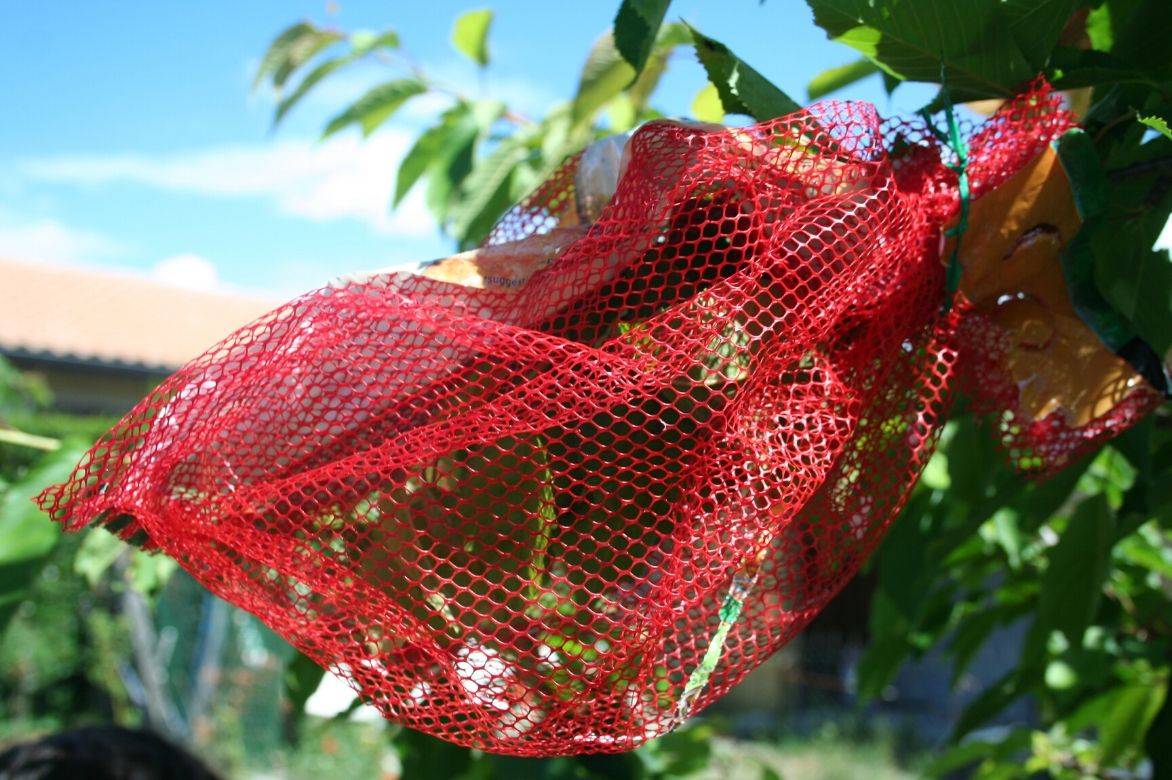
Protective net against bird predation
When and how to prune?
The cherry tree does not tolerate pruning well as it creates wounds that serve as entry points for diseases and encourages the flow of gum (gummosis: secretion of an amber-coloured “resin” on the wounds), which weakens the tree. However, it is sometimes necessary to prune to limit its size or when certain branches become too fragile. Pruning of the cherry tree should be done every 3 to 4 years in autumn, after leaf fall, or in winter, avoiding frost periods.
Training pruning
In the early years, perform training pruning to give it the desired shape: cut the main branches back by a third of their length. A cherry tree can be pruned into a spindle shape, goblet shape, trained, or left free.
A goblet shape facilitates fruit picking:
→ to read on the subject: “How to train a fruit tree in goblet shape?”
Maintenance pruning
- Remove suckers growing at the base of the tree and water sprouts developing on the trunk
- Eliminate dead, fragile, or broken branches and those crossing inside, to allow air and light to circulate in the centre of the branches
- Shorten young shoots to maintain a balanced canopy
- Seal pruning wounds with a healing paste to prevent the appearance of fungi or diseases
Fruit pruning
This is carried out on well-established cherry trees and aims to improve the tree’s productivity.
- Remove buds facing inwards
- Reduce the length of the main branches to strengthen them and help support the weight of the fruit
- Remove those that are dead, damaged, or poorly positioned
Note: rejuvenation pruning is possible for old cherry trees: at the end of summer, prune some of the oldest branches at the base to rejuvenate the framework.
Harvesting cherries
When and how to harvest cherries?
Count on an average of 40 days after flowering to start harvesting your cherries. The picking takes place from May to August depending on the varieties, before the birds get to them and when they are bright red, tender to the touch, and the peduncle should detach easily. The peak season for cherries is July. Do not harvest cherries before they are fully ripe: cherries do not ripen further once picked. Pick them carefully, ensuring to keep their peduncles. You can use a picking pole, a step ladder, or a double ladder, depending on the height of your tree. The harvest can vary and be more or less abundant from year to year: your cherry tree simply replenishes its reserves for the following year. On average, in a garden, an adult cherry tree (between 10 and 20 years old) can produce between 20 and 50 kg of cherries.
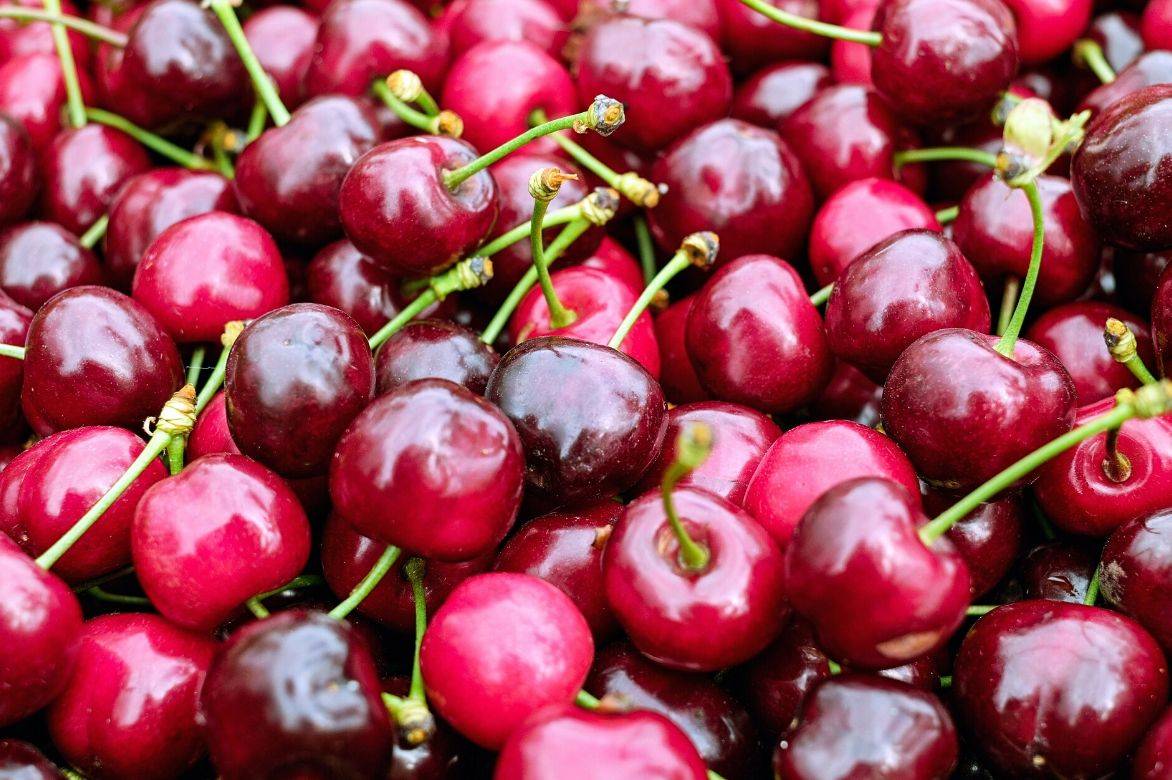
Cherry harvest
The preservation of cherries
Cherries are delicate fruits that once picked must be consumed quickly to retain their full flavour. Store them for one or two days in a fruit bowl away from heat. They can be kept in the vegetable drawer of the refrigerator for only 2-3 days.
Cherries freeze very well once pitted and stemmed. If the harvest is abundant, they can also be preserved in jars (brandy cherries, liqueur cherries, compotes, jams…). Sour cherries (morello cherries) are especially used for preserves.
→ Gwenaëlle tells you everything in how to harvest and store cherries?
Use of cherries
Cherry is the sweetest of red fruits. It is a very juicy fruit, rich in vitamin C, minerals, and trace elements. While cherries are delicious to eat raw right after picking, they are also suitable for a variety of sweet or savoury recipes and can be enjoyed in cakes, tarts, clafoutis, fruit salads, and jams. Cooked, they also serve as an accompaniment for game and duck. They are used to make highly sought-after liqueurs and spirits: kirsch, ratafia, or even maraschino from Italy. The cherry stalks are renowned for their expectorant and astringent properties and are used in detox teas.
→ Discover How to make cherry syrup?; How to make dried cherries; How to dry and use cherry stalks?
Diseases and pests of cherry trees
The Fruit Cherry Tree is susceptible to brown rot, which causes the flowers to dry out, with greyish small cushions appearing. This disease, caused by a fungus favoured by humid spring weather, can also affect the leaves, branches, and the fruits, which become covered in grey and also dry out. The cherries then rot on the tree. Remove and burn the affected parts immediately and spray with Bordeaux mixture in early spring and autumn.
Grey rot is another fungal disease that can threaten your cherry tree: a velvety, grey rot develops on the fruits, rendering them unfit for consumption: pluck and burn the affected fruits and parts; you can spray a horsetail decoction or garlic decoction or Bordeaux mixture every 15 days.
Leaf spot disease is yet another fungal disease that is often fatal: the leaves turn a silvery colour. Remove the infected branches and any diseased parts or those showing early symptoms: cover the wounds with a fungicidal healing paste and then spray with a burdock or valerian manure.
The bacterial canker is a fairly common disease in fruit trees: it is recognised by the drying of floral bouquets, brown spots, and the deformations of the bark it causes. As a preventive measure, treat the tree with Bordeaux mixture in autumn and follow our advice for combating canker.
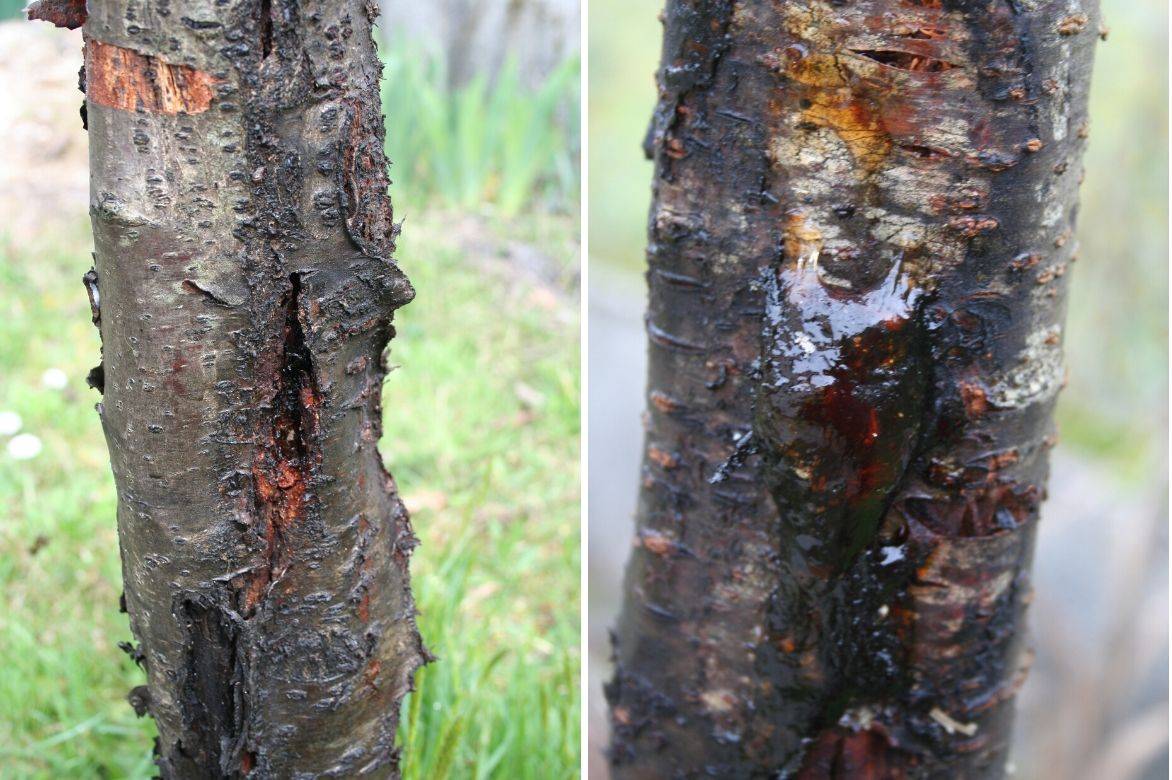
Appearance of canker on a cherry tree
It can also happen that scale insects attack the Cherry Tree, leading to the appearance of a white deposit on the leaves, a non-dangerous but unsightly condition: treat by spraying black soap on the foliage.
In spring, black aphids may attack the leaves, causing them to curl and wilt: simply treat by spraying soapy water or a mixture of water and vegetable oil.
Finally, the cherry fruit fly is well known for being responsible for the presence of maggots. To learn more, visit this article: “The Cherry Fruit Fly: Prevention and Treatment”
Also, read our topic on Gummosis in stone fruit trees.
Cherry tree propagation
The cherry tree is propagated by sowing the stone, a method that requires a lot of patience, by sucker, but mainly by grafting, which is a technique that demands a certain level of skill.
By grafting
Cleft grafting is carried out from July to August.
- Using a grafting knife, make a T-shaped cut on the rootstock about ten centimetres high from the base: lift the bark without cutting into the wood.
- On a well-established cherry tree, take a 20 cm long shoot from the current year’s growth of the variety you wish to propagate (the scion).
- Remove a healthy bud, and trim the scion to a wedge shape on both sides.
- Lift the bark on either side of the vertical slit in the rootstock and slide in the scion.
- Push it down to the bottom of the slit.
- Wrap the grafting point with raffia around the trunk, leaving the bud exposed.
- Seal the grafting point with grafting wax to make it airtight.
- Wait for the buds to develop!
Useful resources
- All the tips for beautiful fruit trees are on our blog
- Discover our wide range of fruit trees, from the most classic to the most original and exotic!
- Article: Cherry tree: the best varieties
- Article: How to choose a cherry tree? and Dwarf cherry trees, perfect for balconies, terraces, and small spaces
- Article: Self-fertile cherry trees, perfect for small gardens.
- Article: How to make dried cherries?
- Article: Diseases and pests of the cherry tree
- Article: Fruit trees: the most popular self-fertile varieties
- Pascale explains why a cherry tree does not produce fruit
- Discover Old and local cherry tree varieties: fruit trees to plant and preserve
- Article: Which cherry tree to plant for a harvest of large sweet cherries?
- Subscribe!
- Contents
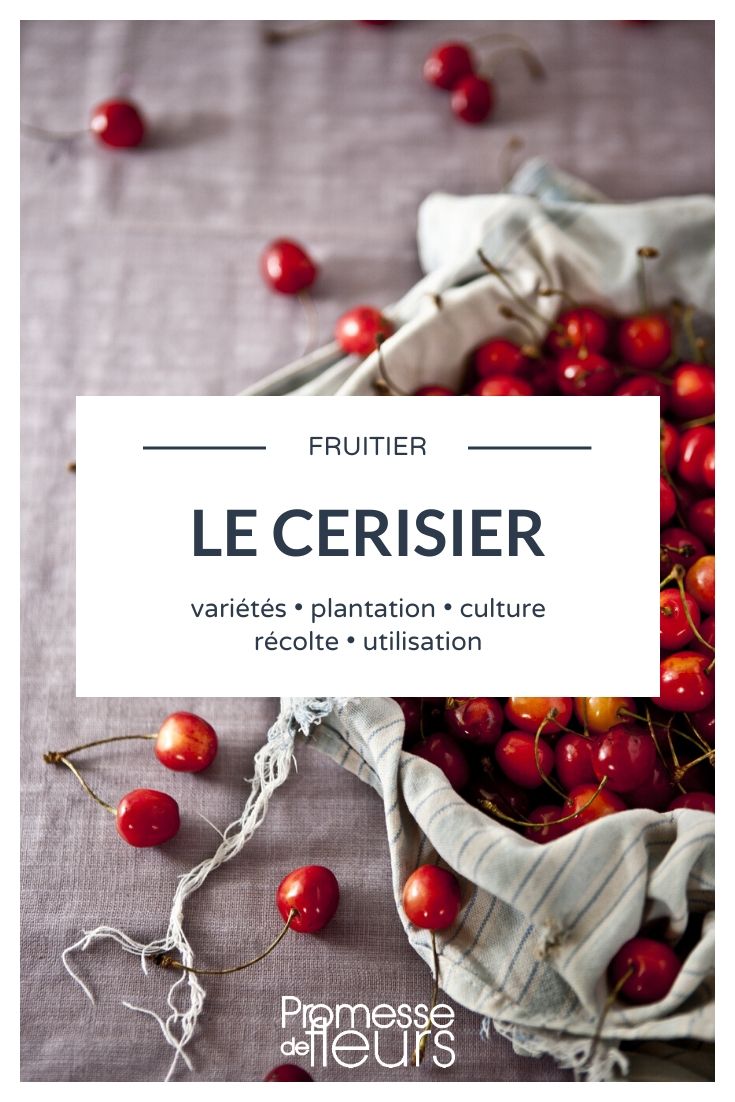































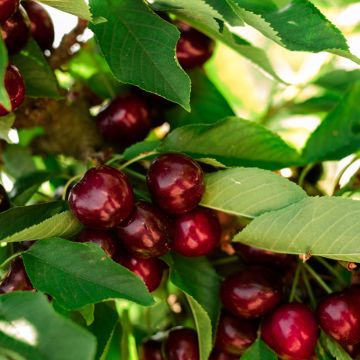
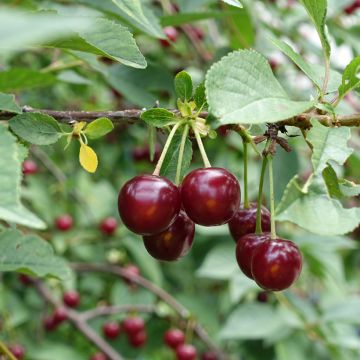
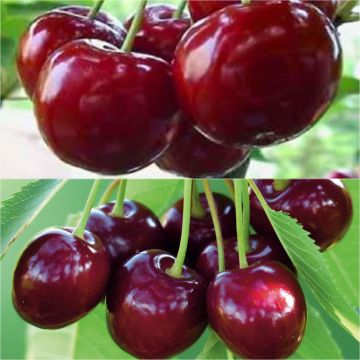
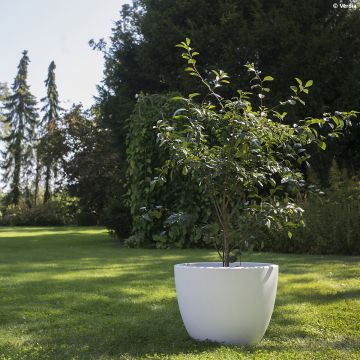
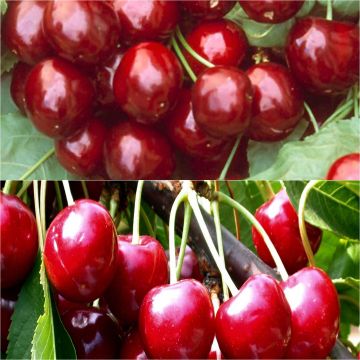

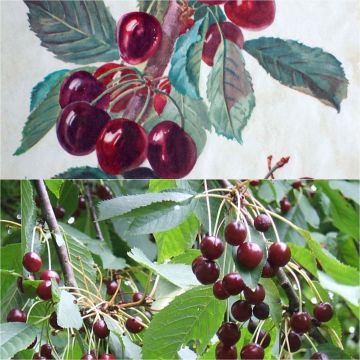

Comments